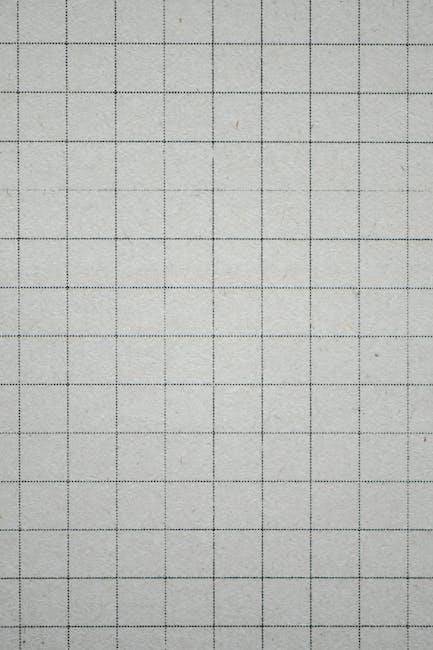ADHD planners are essential tools designed to help individuals manage time, organize tasks, and maintain focus. They offer structured formats, goal-setting features, and mood trackers to enhance productivity and reduce stress.

Benefits of Using an ADHD Planner
Using an ADHD planner offers numerous benefits, helping individuals manage symptoms effectively. It enhances organization, reduces stress, and improves focus by breaking tasks into manageable steps. Features like daily schedules, goal setting, and mood trackers promote accountability and self-awareness. Brain dump sections provide a space to unload thoughts, minimizing overwhelm. By prioritizing tasks and setting realistic time goals, users can boost productivity and maintain a balanced routine. The planner also fosters consistency, helping individuals stay on track with habits and responsibilities. Over time, it can reduce procrastination and improve overall well-being. With customizable options, ADHD planners cater to unique needs, making them a versatile tool for enhancing daily life and long-term success.

Key Features of an Effective ADHD Planner
An effective ADHD planner includes daily schedules, goal-setting templates, brain dump sections, mood trackers, and PDF format for easy customization and printing, catering to diverse organizational needs.
3.1 Daily Schedules
Daily schedules are a cornerstone of ADHD planners, providing a structured framework for managing time. By breaking down tasks into manageable time blocks, individuals can prioritize activities, set realistic goals, and maintain focus. These schedules often include space for noting start and end times, task descriptions, and breaks, helping to create a balanced routine. The rigid yet flexible structure supports accountability and reduces overwhelm, making it easier to stay on track. Many planners also incorporate reward systems or motivational cues to encourage adherence. With a clear visual layout, daily schedules become a powerful tool for enhancing productivity and reducing procrastination, tailored to the unique needs of those with ADHD.
3.2 Goal Setting
Goal-setting sections in ADHD planners are tailored to help individuals establish and track both short-term and long-term objectives. These sections often include templates for breaking down larger goals into smaller, actionable steps, making them feel more manageable and less overwhelming. Many planners incorporate the SMART goal framework—Specific, Measurable, Achievable, Relevant, and Time-bound—to ensure clarity and accountability. Additionally, space for reflecting on progress and adjusting goals as needed is a common feature. By providing a structured approach to goal setting, these planners help individuals stay focused, celebrate accomplishments, and maintain momentum. This tool is particularly useful for those who struggle with procrastination or difficulty in maintaining long-term direction, offering a clear path to achieving their aspirations.
3.3 Brain Dump Sections
Brain dump sections in ADHD planners provide a dedicated space for quickly jotting down thoughts, ideas, and tasks without structure or organization. This feature is particularly helpful for individuals with ADHD, as it allows them to unload mental clutter and reduce overwhelm. By offering a free-form area to capture information, brain dump sections help users clear their minds and regain focus. Many planners include prompts or bullet-point lists to make the process easier, while others offer blank spaces for maximum flexibility. This tool is especially useful for managing the constant flow of ideas and tasks that can be challenging to keep track of. By organizing thoughts in one place, individuals can later review and prioritize them, enhancing overall productivity and mental clarity. This feature is a cornerstone of effective ADHD planning systems, designed to accommodate the unique cognitive needs of neurodivergent individuals.
3.4 Mood Trackers
Mood trackers are a valuable feature in ADHD planners, providing a space to monitor and understand emotional fluctuations. These sections often include daily checklists or visual scales to rate emotions, stress levels, or energy. By tracking moods over time, individuals can identify patterns and triggers, enabling better emotional regulation. Some planners incorporate color-coded systems or icons for quick and intuitive logging. This tool not only helps in managing emotional overwhelm but also fosters self-awareness and mindfulness. Many users find it helpful to reflect on their mood tracker at the end of the week or month to gain insights and improve emotional well-being. Mood tracking is a key component of ADHD planners, supporting holistic management of both tasks and emotions. It encourages proactive strategies for maintaining stability and mental health.
3.5 Why PDF Format is Ideal
The PDF format is highly suitable for ADHD planners due to its versatility and accessibility. PDFs can be easily downloaded and printed, allowing users to have a physical copy that they can carry with them. This portability is crucial for individuals who need constant reminders and organization tools. Additionally, PDFs are universally compatible, meaning they can be opened on any device without requiring specific software. This accessibility ensures that users can access their planner from their smartphone, tablet, or computer, providing convenience and flexibility. Moreover, PDFs often include editable features, enabling users to customize their planner according to their needs. This personalization aspect is particularly beneficial for individuals with ADHD, as it allows them to tailor the planner to their unique requirements. Furthermore, PDFs are easy to store, taking up minimal space on digital devices, and they maintain consistent formatting across different platforms. This consistency is comforting for users who appreciate a uniform and predictable structure. The ability to print PDFs also makes them environmentally friendly, as users can choose to print only the necessary pages. Lastly, PDF planners are often cost-effective, with many free or low-cost options available, making them accessible to a wide audience. Overall, the PDF format combines practicality, customization, and accessibility, making it an ideal choice for ADHD planners.
Choosing the Right ADHD Planner
Selecting the right ADHD planner involves considering personal preferences and specific needs. Look for a planner that offers customizable templates, allowing you to tailor it to your daily routines and goals. Ensure it includes features such as daily schedules, goal-setting sections, and mood trackers, which are essential for managing ADHD symptoms. Additionally, consider the format—PDF planners are ideal due to their ease of use and versatility. Check for reviews or recommendations from others with ADHD to find a planner that aligns with your lifestyle. Finally, evaluate whether you prefer a printable or digital version, as this will impact how you use the planner. Taking the time to choose the right tool can significantly enhance its effectiveness in improving organization and focus.
How to Use an ADHD Planner Effectively
Start by personalizing your ADHD planner to fit your lifestyle and needs. Establish a consistent daily routine, breaking tasks into manageable steps and scheduling regular breaks. Utilize the brain dump section to clear mental clutter and reduce stress. Regularly track your mood and energy levels to identify patterns and triggers. Make the most of the PDF format by keeping it editable and accessible on multiple devices. Maintain consistency by reviewing and updating your planner daily, and consider pairing it with other organizational tools for enhanced effectiveness. Regularly review and adjust your planner to ensure it continues to support your evolving needs and goals.
5.1 Setting Up Your Planner
Setting up your ADHD planner begins with personalizing it to suit your unique needs. Start by reviewing all sections, such as daily schedules, goal-setting templates, and brain dump areas. Familiarize yourself with the layout and ensure it aligns with your daily routines. Print or download the PDF version and organize the pages in a way that feels intuitive to you. Consider adding stickers, colors, or tabs to make the planner visually appealing and engaging. Begin with a “brain dump” to clear your mind and transfer tasks into the planner. Set clear intentions for how you’ll use the planner daily, such as dedicating specific times for updates. Finally, place your planner in a visible, accessible location to encourage consistent use and make it a habit. Tailor every step to your preferences for maximum effectiveness.
5.2 Creating a Daily Routine
Creating a daily routine with an ADHD planner helps establish structure and consistency. Start by blocking time for essential tasks, prioritizing them based on importance and energy levels. Break larger tasks into smaller, manageable steps to avoid overwhelm. Schedule regular breaks and incorporate reward systems to stay motivated. Include dedicated spaces for self-care, such as exercise or mindfulness practices, to promote balance. Use the planner’s sections to track progress and reflect on what works best for you. Customize the routine to fit your unique needs and preferences, ensuring it’s realistic and adaptable. Regularly review and adjust the routine to maintain effectiveness and prevent stagnation. By creating a structured yet flexible daily plan, you can enhance focus, reduce procrastination, and achieve your goals more efficiently.

Tips for Maximizing Planner Benefits
To maximize the benefits of an ADHD planner, consistency is key. Start by making it a habit to use the planner daily, even for small tasks. Break down larger goals into smaller, actionable steps to avoid feeling overwhelmed. Regularly review and adjust your plans to stay on track. Customize the planner to suit your needs, adding personal motivators like stickers or colors. Use the brain dump section frequently to clear mental clutter and reduce stress. Highlight priorities to maintain focus and celebrate small wins to boost motivation. Finally, pair your planner with digital tools for seamless integration and reminders. By staying consistent and adaptable, you can unlock the full potential of your ADHD planner and improve overall productivity.

The Best ADHD Planner PDFs Available
Several high-quality ADHD planner PDFs are available, designed to cater to diverse needs. The ADHD Daily Planner Template is a popular choice, offering daily schedules, goal-setting sections, and mood trackers. Another top option is the Ultimate ADHD Life Planner, which includes customizable templates for task management and habit tracking. Many planners are available in both free and paid versions, with downloadable formats like PDF, SVG, and PNG. These tools are tailored to help users prioritize tasks, manage time effectively, and maintain focus. By leveraging these resources, individuals with ADHD can create structured routines and improve overall productivity. The best planners are those that align with personal preferences and provide flexibility for customization, ensuring a tailored approach to organization and goal achievement.
Free vs. Paid ADHD Planners
When choosing an ADHD planner, users often debate between free and paid options. Free planners, such as the ADHD Daily Planner Template or Printable ADHD Adult Planner, offer basic yet effective tools for task management and goal setting. They are ideal for those on a budget or exploring planner options. Paid planners, like the Ultimate ADHD Life Planner, provide advanced features, customization, and premium designs. Paid versions often include editable PDFs, additional templates, and ongoing support. While free planners are a great starting point, paid options offer more flexibility and comprehensive tools for long-term use. Both options are widely available online, with many downloadable in formats like PDF, PNG, and SVG. The choice depends on individual needs and preferences for functionality and design.

Customizing Your ADHD Planner
Customizing your ADHD planner is key to making it effective. Many planners, such as the ADHD Life Planner, offer editable PDFs or Canva templates, allowing users to tailor sections like daily schedules, goal-setting, and mood trackers to their needs. Some planners include a variety of pages, enabling users to select and print only what they need. Digital tools allow for color customization and personalization, which can enhance engagement and motivation. Additionally, brain dump sections and reward systems can be adapted to suit individual preferences. The ability to customize ensures the planner remains relevant and useful over time, helping users maintain organization and focus without feeling overwhelmed. This flexibility makes ADHD planners a versatile tool for managing daily life effectively.

Digital vs. Printable ADHD Planners
When choosing between digital and printable ADHD planners, consider your personal preferences and needs. Digital planners, often available as editable PDFs, offer flexibility and convenience, allowing customization via tools like Canva. They can be accessed on multiple devices, making them ideal for on-the-go use. Printable planners, however, provide a tactile experience, which many find more engaging and satisfying. They can be easily annotated and are perfect for those who prefer physical organization. Some planners, like the ADHD Life Planner, offer both digital and printable versions, giving users the best of both worlds. Ultimately, whether digital or printable, the goal is to find a format that enhances productivity and reduces overwhelm, helping you stay organized and focused.

ADHD Planners for Specific Needs
ADHD planners are available to cater to diverse needs, ensuring everyone can find a format that suits their unique requirements. For adults, planners often include sections for daily tasks, goal-setting, and self-care, while student-focused planners may emphasize academic organization. Some planners are designed specifically for time management, offering detailed schedules and break-down tools. Others focus on emotional regulation, incorporating mood trackers and stress management tips. The Ultimate ADHD Planner and ADHD Life Planner are popular choices, providing customizable templates to address individual challenges. Whether you need help with daily routines, long-term goals, or emotional well-being, there’s a planner tailored to your specific needs, ensuring you stay organized and focused. These tools are evidence-based and designed to empower individuals with ADHD to thrive.
